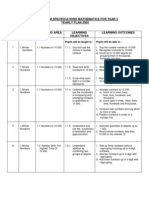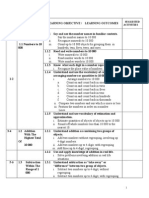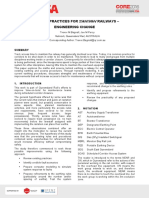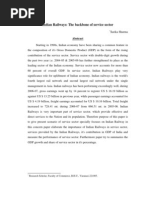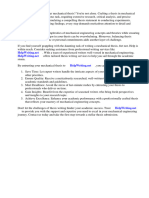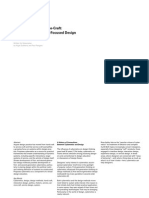Yearly Plan Math Year 5 2013
Yearly Plan Math Year 5 2013
Uploaded by
rdmasrinCopyright:
Available Formats
Yearly Plan Math Year 5 2013
Yearly Plan Math Year 5 2013
Uploaded by
rdmasrinCopyright
Available Formats
Share this document
Did you find this document useful?
Is this content inappropriate?
Copyright:
Available Formats
Yearly Plan Math Year 5 2013
Yearly Plan Math Year 5 2013
Uploaded by
rdmasrinCopyright:
Available Formats
SCHEME OF WORK MATHEMATICS YEAR FIVE
WEEK
TOPIC 1. WHOLE NUMBERS
LEARNING AREA Numbers to 1 000 000
LEARNING OBJECTIVES Pupils will be taught to: 1. Develop number sense up to 1 000 000
LEARNING OUTCOMES Pupils will be able to: i. Name and write numbers up to 1 000 000. ii. Determine the place value of the digits in any whole number up to 1 000 000. iii. Compare value of numbers to 1 000 000. iv. Round off numbers to the nearest tens, hundreds, thousands, ten thousands and hundred thousands.
1
2/1/13 4/1/13
2
7/1/13 11/1/13
Addition With the highest Total of 1 000 000 Subtraction Within the Range
2. Add numbers to the total of 1 000 000
i. Add any two to four numbers up to 1 000 000. ii. Solve addition problems.
3. Subtract numbers from a number less than 1
i. Subtract one number from a bigger number less than 1 000 000 ii. Subtract successively from a bigger number less than 1 000 000
3
14/1/13 18/1/13
Multiplication with 4. Multiply any two the highest Product of numbers with the highest 1 000 000 product of 1 000 000
iii. Solve subtraction problems. i. Multiply up to five digit numbers with a) a one-digit number b) a two-digit numbers c) 10,100 and 1 000 ii. Solve problems involving multiplication
4
21/1/13 25/1/13
Division with the highest Dividend of 1 000 000
5. Divide a number less than 1 000 000 by a twodigit number.
i. Divide numbers up to six digits by a) a one-digit number b) 10, 100 and 1 000 c) a two-digit number
WEEK
TOPIC
LEARNING AREA
LEARNING OBJECTIVES Pupils will be taught to:
LEARNING OUTCOMES Pupils will be able to: ii. Solve problems involving division.
5
28/1/13 1/2/13
1. WHOLE NUMBERS
Mixed Operations
6. Perform mixed operation involving multiplication and division
i. Calculate mixed operations on whole numbers involving multiplication and division. ii. Solve problems mixed operation of multiplication and division.
6
4/2/13 8/2/13
2. FRACTIONS
Improper Fractions
1. Understand improper fractions.
i. Name and write improper fractions with denominators up to 10. ii. Compare the value of two improper fractions.
Mixed numbers
2. Understand mixed numbers
i. Name and write mixed numbers with denominators up to 10. ii. Convert improper fractions to mixed number and viceversa.
7 8
18/2/13 22/2/13
CUTI SEMPENA TAHUN BARU CINA ( 9/2/13 - 17/2/13 ) Addition of Fractions 3. Add two mixed numbers i. Add two mixed numbers with the same denominators up to 10. ii. Add two mixed numbers with different denominators up to 10. iii. Solve problems involving subtraction of mixed numbers.
9
25/2/13 1/3/13
Subtraction of Fractions
4. Subtract mixed numbers
i. Subtract two mixed numbers with the same denominators up to 10. ii. Subtract two mixed numbers with different denominators
WEEK
TOPIC
LEARNING AREA
LEARNING OBJECTIVES Pupils will be taught to:
LEARNING OUTCOMES Pupils will be able to: up to 10. iii. Solve problems involving Subtraction of mixed numbers.
10 11
11/3/13 15/3/13
2. FRACTIONS
PENILAIAN FASA 1 TAHAP 2 ( 4/3/13 - 8/3/13 ) Multiplication of 5. Multiply any proper i. Multiply whole numbers Fraction fractions with a whole 1 with proper fractions. 000 ii. Solve problems involving multiplication of fractions. Decimal Numbers 1. Understand and use the vocabulary related to decimals i. Name and write decimal numbers to three decimal places. ii. Recognize the place value of thousandths. iii. Convert fractions of thousandth to decimal numbers and vice-versa. iv. Round off decimal numbers to nearest a) tenths b) hundredths CUTI PERTENGAHAN PENGGAL 1 ( 23/3/13 - 31/3/13 ) Addition of Decimal 2. Add decimals up to three Number decimal places. i. Add any two to four decimal numbers up to three decimal places involving a) decimal numbers and decimal numbers. b) whole numbers and decimal numbers. ii. Solve problems involving addition of decimal numbers.
12
18/3/13 22/3/13
3. DECIMALS
13
1/4/13 5/4/13
WEEK
TOPIC
LEARNING AREA Subtraction of Decimal Numbers
LEARNING OBJECTIVES Pupils will be taught to: 3. Subtract decimal numbers up to three decimal places.
LEARNING OUTCOMES Pupils will be able to: i. Subtract a decimal number from another decimal number up to three decimal places. ii. Subtract successively any two decimal numbers up to three decimal places. iii. Solve problems involving subtraction of decimal numbers.
14
8/4/13 12/4/13
15
15/4/13 19/4/13
3. DECIMALS
Multiplication of Decimal Numbers
4. Multiply decimals up to three decimal places with a whole number
i.
Multiply any decimal numbers up to three decimal place with a) a one-digit number b) a two-digit number c) 10, 100 and 1 000 Solve problems involving multiplication of decimal numbers.
ii.
16
22/4/13 26/4/13
Division of Decimal Numbers
5. Divide decimal numbers up to three decimal places by a whole number.
i. Divide a whole number by a) 10 b) 100 c) 1 000 ii. Divide a whole number by a) a one-digit number b) a two-digit whole number iii. Divide a decimal number of three decimal places by a) a one-digit number b) a two-digit whole number c) 10 d) 100 iv. Solve problems involving division of decimal numbers.
WEEK
TOPIC 4.
PERCENTAGE
LEARNING AREA Percentage
LEARNING OBJECTIVES Pupils will be taught to: 1. Understand and use percentage.
LEARNING OUTCOMES Pupils will be able to: i. Name and write the symbol for percentage. ii. State fraction of hundredths in percentage. iii. Convert fraction of hundredths to percentage and vice-versa.
17
29/4/13 3/5/13
18 19
13/4/13 17/5/13
4.
PERCENTAGE
PENILAIAN PERTENGAHAN TAHUN 2013 ( 6/5/13 - 10/5/23 ) Convert Fractions 2. Relate fractions and i. Convert proper fractions of and Decimals to decimals to percentage. tenths to percentage. Percentage ii. Convert proper fractions with the denominator of 2, 4, 20, 25 and 50 to percentage. iii. Convert percentage to fraction in its simplest form. iv. Convert percentage to decimal number and viceversa.
20 21
10/6/13 14/6/13
5. MONEY
REVISION & REMARKING CUTI PERTENGAHAN TAHUN 2013 (24/5/2013 9/6/2013) Money to 1. Understand and use the i. Read and write the value of RM100 000 vocabulary related to money in ringgit and sen up money. to RM 100 000 2. Use and apply mathematical concepts when dealing money up to RM100 000. i. Add money in ringgit and sen up to RM100 000 ii. Subtract money in ringgit and sen within the range of RM100 000 iii. Multiply money in ringgit and sen with a whole number, fraction or decimal with products within RM100 000 5
22
17/6/13 21/6/13
23
24/6/13 28/6/13
WEEK
TOPIC
LEARNING AREA
LEARNING OBJECTIVES Pupils will be taught to:
LEARNING OUTCOMES Pupils will be able to: iv. Divide money in ringgit and sen with dividend up to RM100 000 v. Perform mixed operation of multiplication and division involving money in ringgit and sen up to RM100 000 vi. Solve problems in real context involving money in ringgit and sen up to RM100 000
24
1/7/13 5/7/13
6. TIME
Reading and writing Time
1. Understand the vocabulary related to time
i. Read and write time in 24hour system. ii. Relate the time in the 24hour system to the 12-hour system. iii. Convert time from the 24hour system to the 12-hour system and vice-versa.
25
8/7/13 12/7/13
6. TIME
Relationship Between 2. Understand the Units of Time relationship between units of time.
i. Convert time in fractions and decimals of a minute to seconds. ii. Convert time in fractions and decimals of an hour to minutes and to seconds. iii. Convert time in fractions and decimals of a day to hours, minutes and to seconds. iv. Convert units of time from a) Century to years and viceversa. b) Century to decades and vice-versa
WEEK
TOPIC
LEARNING AREA Basic Operations Involving Time
LEARNING OBJECTIVES Pupils will be taught to: 3. Add, subtract, multiply and divide units of time.
LEARNING OUTCOMES Pupils will be able to: i. Add time in hours, minutes and seconds. ii. Subtract time in hours, minutes and seconds. iii. Multiply time in hours, minutes and seconds. iv. Divide time in hours, minutes and seconds.
26
15/7/13 19/7/13
27 28
29/7/13 2/8/13
PENILAIAN FASA 2 TAHAP 2 ( 22/7/13 - 26/7/13 ) Duration 4. Use and apply i. Identify the start and end knowledge of time to find times of an event the duration ii. Calculate the duration of an event involving a) hours, minutes and seconds b) days and hours iii. Determine the start or end times from a given duration of time. iv. Solve problems involving time duration in fractions and/or decimals of hours, minutes and seconds.
29
5/8/13 6/8/13
7. LENGTH
Measuring Length
1. Measure and compare distances
i. Describe by comparison the distance of one kilometre ii. Measure using scales for distance between places
Relationship between units of length
2. Understand the relationship between units of length.
i. Relate metre and kilometre. ii. Convert metre to kilometre and vice-versa.
CUTI PERTENGAHAN PENGGAL 2 ( 7/8/13 - 18/8/13 ) 7
WEEK
TOPIC
LEARNING AREA Basic Operations Involving Length
LEARNING OBJECTIVES Pupils will be taught to: 3. Add, subtract, multiply and divide units of length.
LEARNING OUTCOMES Pupils will be able to: i. Add and subtract units of length, involving conversion of units in a) kilometres b) kilometres and metres ii. Multiply and divide units of length in kilometres involving conversion of units with a) one-digit number b) 10,100, 1 000
30
19/8/13 23/8/13
31
26/8/13 30/8/13
8. MASS
Comparing Mass
iii. Solve problems involving basic operations on length. 1. Compare mass of objects i. Measure and record of masses of objects in kilograms and grams ii. Comparing the masses of two objects using kilogram and gram, stating the comparison in multiples or fractions. iii. Estimate the masses of objects using kilograms and grams. i. Convert units of mass from fractions and decimals of a kilogram to grams and viceversa. ii. Solve problems involving conversion of mass units in fraction and/or decimals. i. Measure and record the volumes of liquid in a smaller metric unit given the measure in fractions and/or decimals of a larger unit. ii. Estimate the volumes of liquid involving fractions and decimals using litres and millilitres. iii. Compare the volumes of liquid involving fractions
32
2/9/13 6/9/13
2. Understand the relationship between units of mass.
33
9/9/13 13/9/13
9. VOLUME OF LIQUID
Comparing Volume
1. Measure and compare volumes of liquid using standard units.
WEEK
TOPIC
LEARNING AREA
LEARNING OBJECTIVES Pupils will be taught to:
LEARNING OUTCOMES Pupils will be able to: and decimals using litres and millilitres.
34
16/9/13 20/9/13
Relationship Between 2. Understand the Units of Volume relationship between units of volume of liquid.
i. Convert units of volume involving fractions and decimals from litres to millilitres and vice-versa. ii. Solve problems involving volume of liquid.
35
23/9/13 27/9/13
Operations on Volume of Liquid
3. Add and subtract units of volume
36
30/9/13 4/10/13
Operations on Volume of Liquid
4. Multiply and divide units of volume.
i. Add units of volume involving mixed decimals in a) litre b) millilitre c) litre and millilitre ii. Subtract units of volume involving mixed decimals in a) litre b) millilitre c) litre and millilitre i. Multiply units of volume involving mixed decimals using a) a one-digit number b) 10, 100 , 1 000 involving conversion of units. ii. Divide units of volume using a) up to two-digit number b) 10, 100, 1 000 involving mixed decimals. iii. Divide units of volume using a) a one-digit number b) 10, 100, 1 000 involving conversion of units. iv. Solve problems involving computations for volume of liquids.
WEEK
TOPIC
LEARNING AREA Composite TwoDimensional Shapes
LEARNING OBJECTIVES Pupils will be taught to: 1. Find the perimeter of composite two-dimensional shape.
LEARNING OUTCOMES Pupils will be able to: i. Measure the perimeter of the following composite 2-D shapes: a) square and square b) rectangle and rectangle c) triangle and triangle d) square and rectangle e) square and triangle f) rectangle and triangle ii. Calculate the perimeter of the following composite 2-D shapes: a) square and square b) rectangle and rectangle c) triangle and triangle d) square and rectangle e) square and triangle f) rectangle and triangle iii. Solve problems involving perimeters of composite 2-D shapes
37
7/10/13 11/10/13
10. SHAPE and SPACE
38
14/10/13 18/10/13
Composite TwoDimensional Shapes
2. Find the area of composite two-dimensional shape.
i. Measure the area of the following composite 2-D shapes a) square and square b) rectangle and rectangle c) square and rectangle ii. Calculate the area of the following composite 2-D shapes a) square and square b) rectangle and rectangle c) square and rectangle iii. Solve problems involving areas of 2-D shapes
39
21/10/13 25/10/13
10. SHAPE and SPACE
Composite ThreeDimensional Shapes
1. Find the volume of composite 3-D shapes.
i. Measure the volume of the following composite 3-D shapes for a) a cube and another cube b) a cuboid and another
10
WEEK
TOPIC
LEARNING AREA
LEARNING OBJECTIVES Pupils will be taught to:
LEARNING OUTCOMES Pupils will be able to: cuboid c) a cube and a cuboid ii. Calculate the volume of the following composite 3-D shapes for a) a cube and another cube b) a cuboid and another cuboid c) a cube and a cuboid iii. Solve problems involving volume of composite 3-D shapes i. Describe the meaning of average. ii. State the average of two or three quantities. iii. Determine the formula for average.
40
28/10/13 1/11/13
11. DATA HANDLING
Average
1. Understand and use the vocabulary related to average.
2. Use and apply knowledge of average
i. Calculate the average using formula. ii. Solve problems in real life situation. i. Recognise frequency, mode, range, maximum and minimum value from bar graphs. i. Construct a bar graph from given set of data.
41
4/11/13 8/11/13
Organising and interpreting data
1. Understand the vocabulary relating to data organisation in graphs. 2. Organise and interpret data from tables and charts.
ii. Determine the frequency, mode, range, maximum and minimum value from a given bar graph. PENILAIAN AKHIR TAHUN 2013 ( 11 / 11/ 2013 15 / 11 / 2013 ) CUTI AKHIR TAHUN ( 16/11/2013 31/12/2013 )
11
You might also like
- Position vs. Time Graphs: Constant Velocity Particle Model Worksheet 3Document5 pagesPosition vs. Time Graphs: Constant Velocity Particle Model Worksheet 3Sidney Bittner100% (2)
- Let's Practise: Maths Workbook Coursebook 2From EverandLet's Practise: Maths Workbook Coursebook 2No ratings yet
- Evaluation of Road Traffic Accidents and Injuries Rtai Along Emilio Aguinaldo Highway in Dasmariñas City AreaDocument47 pagesEvaluation of Road Traffic Accidents and Injuries Rtai Along Emilio Aguinaldo Highway in Dasmariñas City AreaChristian Nathaniel Ramon PalmaNo ratings yet
- RPT MT THN4Document14 pagesRPT MT THN4hafidie83No ratings yet
- Maths Year 5Document9 pagesMaths Year 5Nurul KikinNo ratings yet
- RPT & Plan-J Math Year 5 2012Document26 pagesRPT & Plan-J Math Year 5 2012sapuanazianNo ratings yet
- Topic Learning Area Learning Objectives Learning Outcomes: Yearly Plan Mathematics Year 5Document19 pagesTopic Learning Area Learning Objectives Learning Outcomes: Yearly Plan Mathematics Year 5ranj19869No ratings yet
- RPT MT THN4Document14 pagesRPT MT THN4Malcom X MalcomNo ratings yet
- Rancangan Tahunan Matematik Tahun 5 - 2012Document8 pagesRancangan Tahunan Matematik Tahun 5 - 2012mrdan100% (1)
- RPT: Mathematics Year 5Document20 pagesRPT: Mathematics Year 5man_zero1984No ratings yet
- RPT & Plan-J Math Year 5 2010Document20 pagesRPT & Plan-J Math Year 5 2010Zoe KooNo ratings yet
- RPT & Plan-J Math Year 4Document27 pagesRPT & Plan-J Math Year 4Syafiah EppieNo ratings yet
- RPT MT THN4Document17 pagesRPT MT THN4Yakin DayyanNo ratings yet
- Rancangan Tahunan Matematik Tahun 5 2013Document8 pagesRancangan Tahunan Matematik Tahun 5 2013Nurulnaim OmarNo ratings yet
- Yearly Scheme of Work Year 4: Norahazleenda Hairuman SK Trolak SelatanDocument16 pagesYearly Scheme of Work Year 4: Norahazleenda Hairuman SK Trolak SelatanSalwa HanimNo ratings yet
- Mathematics Year 3 2012Document12 pagesMathematics Year 3 2012Izyan IsmailNo ratings yet
- RPT MT THN4Document14 pagesRPT MT THN4startecerNo ratings yet
- Mathematics Yearly Plan (Year 5) 2010: WE EK Topic / Learning Areas Learning Objectives / Learning Outcome RemarksDocument10 pagesMathematics Yearly Plan (Year 5) 2010: WE EK Topic / Learning Areas Learning Objectives / Learning Outcome RemarksMoorsyidee MokhtaruddinNo ratings yet
- Yearly Plan Mathematic Year 6Document8 pagesYearly Plan Mathematic Year 6Rosni OthmanNo ratings yet
- Rancangan Tahunan Math Tahun 5 2012 MS Excell Shared by AzyDocument13 pagesRancangan Tahunan Math Tahun 5 2012 MS Excell Shared by AzyTravis MonroeNo ratings yet
- RPT MT THN4Document14 pagesRPT MT THN4Sk Saujana Impian DuaNo ratings yet
- Rancangan Tahunan Matematik Tahun 6 - 2012Document6 pagesRancangan Tahunan Matematik Tahun 6 - 2012mrdanNo ratings yet
- RPT Math Tahun 4 2013Document11 pagesRPT Math Tahun 4 2013Preloved BoutiqeuNo ratings yet
- Yearly Plan Year 3Document8 pagesYearly Plan Year 3Shima OmarNo ratings yet
- Year3 Mat HSPDocument6 pagesYear3 Mat HSPnorzunita1973No ratings yet
- MT Yearly Plan Year 1 6Document6 pagesMT Yearly Plan Year 1 6abusufian80No ratings yet
- Week Topic / Learning Area Learning Objective / Learning Outcomes Suggested Activities 1 Whole NumbersDocument11 pagesWeek Topic / Learning Area Learning Objective / Learning Outcomes Suggested Activities 1 Whole NumbersGane GanesanNo ratings yet
- Yearly Plan MathsDocument8 pagesYearly Plan MathsTasaratha Rajan AnamalaiNo ratings yet
- Mathematics Yearly Plan (Year 6) Sk. Kem Terendak 1 Encik Ramli Bin BabaDocument4 pagesMathematics Yearly Plan (Year 6) Sk. Kem Terendak 1 Encik Ramli Bin BabaFaridah Binti KamaludinNo ratings yet
- Mathematics Yearly Plan 2014 Year 5 Week Topic / Learning Area Learning Objectives / Learning OutcomesDocument8 pagesMathematics Yearly Plan 2014 Year 5 Week Topic / Learning Area Learning Objectives / Learning OutcomesMohd ZahariNo ratings yet
- RPT Mathematics Year 4Document9 pagesRPT Mathematics Year 4YoNz AliaTiNo ratings yet
- Curriculum Specifications Mathematics Year 3: Week Topic Learning Area Learning Objectives Learning OutcomesDocument23 pagesCurriculum Specifications Mathematics Year 3: Week Topic Learning Area Learning Objectives Learning Outcomesmuhammad syafiq bin arifinNo ratings yet
- Curriculum Specifications Mathematics For Year 3 Yearly Plan 2005Document8 pagesCurriculum Specifications Mathematics For Year 3 Yearly Plan 2005Muhamad IrhamNo ratings yet
- Yearly Scheme of Work Year 4 2013Document15 pagesYearly Scheme of Work Year 4 2013muhdmudzakkirNo ratings yet
- 2010 Yearly Lesson Plan Mathematics Form Two SMK Raja Mahadi KlangDocument12 pages2010 Yearly Lesson Plan Mathematics Form Two SMK Raja Mahadi KlangLooyee ChenNo ratings yet
- Matematik Tahun 2Document6 pagesMatematik Tahun 2Azmin OsmanNo ratings yet
- Mathematics Yearly Plan (Year 4)Document9 pagesMathematics Yearly Plan (Year 4)Mhreal PetronasNo ratings yet
- Year3 Mat HSPDocument8 pagesYear3 Mat HSPShazwani HamzahNo ratings yet
- Rancangan Tahunan Math Tahun 6 - 2013 - BiDocument10 pagesRancangan Tahunan Math Tahun 6 - 2013 - BimrdanNo ratings yet
- RPT MT Y5 2012Document9 pagesRPT MT Y5 2012Ani HaniNo ratings yet
- Form 1Document14 pagesForm 1hai52494578No ratings yet
- Rancangan Tahunan Math Tahun 6 2013 BiDocument10 pagesRancangan Tahunan Math Tahun 6 2013 BiNajwa NurNo ratings yet
- Yearly Lesson Plan Mathematics Form OneDocument14 pagesYearly Lesson Plan Mathematics Form OneAshwinii SegarNo ratings yet
- Rancangan Tahunan Math Tahun 6 2013 BiDocument10 pagesRancangan Tahunan Math Tahun 6 2013 Binaim8889No ratings yet
- Rpt&Plan-j Math Year 4Document27 pagesRpt&Plan-j Math Year 4Kee SekKhaiNo ratings yet
- Year3 Mat HSPDocument8 pagesYear3 Mat HSPyuslinaaNo ratings yet
- Whole NumbersDocument4 pagesWhole Numbersmr.itfreakNo ratings yet
- Mathematics Yearly Plan (Year 5) : Week Topic / Learning Areas Learning Objectives / Learning Outcome RemarksDocument8 pagesMathematics Yearly Plan (Year 5) : Week Topic / Learning Areas Learning Objectives / Learning Outcome RemarksMhreal PetronasNo ratings yet
- Volume of Works Mathematics For Year 3 Delima 2011: 35 QuestionsDocument8 pagesVolume of Works Mathematics For Year 3 Delima 2011: 35 QuestionsaidiladilaNo ratings yet
- RPT MT THN2Document9 pagesRPT MT THN2Muhammad Fadzli HamzahNo ratings yet
- Curriculum Specifications Mathematics For Year 3 Yearly Plan 2005Document8 pagesCurriculum Specifications Mathematics For Year 3 Yearly Plan 2005Khaulah Al-HumayyraNo ratings yet
- Maths Year 3Document0 pagesMaths Year 3SOlero MAniskuNo ratings yet
- RPT MT THN2Document9 pagesRPT MT THN2Hasnawati BachoNo ratings yet
- Year3 Mat HSP SGT BagusDocument9 pagesYear3 Mat HSP SGT BagusMaryah Yahya AzlimdnorNo ratings yet
- Math Yearly Plan Year 3 RPHDocument16 pagesMath Yearly Plan Year 3 RPHnorizan bt awang100% (1)
- Mathematics Yearly Plan (Year Six) : 1. Whole NumbersDocument3 pagesMathematics Yearly Plan (Year Six) : 1. Whole NumbersRamziah BongsuNo ratings yet
- DecimalsDocument3 pagesDecimalsRosnani HassanNo ratings yet
- RT Mat T3Document8 pagesRT Mat T3Candace ClayNo ratings yet
- Mathematics Yearly Plan (Year Six) : 1. Whole NumbersDocument3 pagesMathematics Yearly Plan (Year Six) : 1. Whole NumbersAdemizan AhadNo ratings yet
- Math Fluency Activities for K–2 Teachers: Fun Classroom Games That Teach Basic Math Facts, Promote Number Sense, and Create Engaging and Meaningful PracticeFrom EverandMath Fluency Activities for K–2 Teachers: Fun Classroom Games That Teach Basic Math Facts, Promote Number Sense, and Create Engaging and Meaningful PracticeRating: 4 out of 5 stars4/5 (1)
- Let's Practise: Maths Workbook Coursebook 5From EverandLet's Practise: Maths Workbook Coursebook 5No ratings yet
- Blog 4Document1 pageBlog 4pavithra thanigaivelNo ratings yet
- SF DumpDocument12 pagesSF Dumpnelsonmatosperez949No ratings yet
- Final Project PPT AquebDocument20 pagesFinal Project PPT AquebKlien Parker100% (1)
- Earthing Practices For 25Kv/50Kv Railways - Engineering ChangeDocument8 pagesEarthing Practices For 25Kv/50Kv Railways - Engineering ChangeSantosh IyerNo ratings yet
- LouvresDocument1 pageLouvresFernando RodríguezNo ratings yet
- FsaveddfeedjDocument48 pagesFsaveddfeedjPradhika ArdaniNo ratings yet
- Kalms Tablets PIL 10008432Document4 pagesKalms Tablets PIL 10008432Sören LerbitschewitzNo ratings yet
- Application Story: Mill Ladle Refractory MonitoringDocument2 pagesApplication Story: Mill Ladle Refractory MonitoringAnonymous Wu6FDjbNo ratings yet
- Indian Railways-The Backbone of Service SectorDocument10 pagesIndian Railways-The Backbone of Service SectorRadhakrishnan KrishnamoorthyNo ratings yet
- Raise Organic ChickenDocument51 pagesRaise Organic ChickenRegie Macaya100% (1)
- SOP AMBL 105A TotalSolidsDocument5 pagesSOP AMBL 105A TotalSolidsWijianto WijiantoNo ratings yet
- Brioche BreadDocument3 pagesBrioche BreadNilam MashelNo ratings yet
- Halal Certificate C100Document2 pagesHalal Certificate C100Nikodhemus SusantoNo ratings yet
- Hodder Workbook - Space PhysicsDocument8 pagesHodder Workbook - Space Physicschevie.cute.unicornNo ratings yet
- Folha de Setup Serpent 733Document1 pageFolha de Setup Serpent 733falkratzNo ratings yet
- Floor Plan 1 StoreyDocument1 pageFloor Plan 1 StoreyMa. Janina CincoNo ratings yet
- Lusensi Periapikal Panoramik-BF-1 Juli 2020Document19 pagesLusensi Periapikal Panoramik-BF-1 Juli 2020Roberto HutapeaNo ratings yet
- DIY Coaster-HeartytDocument10 pagesDIY Coaster-HeartytLiz De CerezaNo ratings yet
- Learn The Basics First!: Flip FlopsDocument7 pagesLearn The Basics First!: Flip FlopsBharath Kumar100% (1)
- Mechanical ThesisDocument5 pagesMechanical Thesistiffanyrobinsonmilwaukee100% (2)
- Sensor Directional Power 5010B 5014 Series 08172017Document2 pagesSensor Directional Power 5010B 5014 Series 08172017Nguyễn Công CườngNo ratings yet
- Second Order CyberneticsDocument23 pagesSecond Order Cyberneticsapi-8348981No ratings yet
- Danfoss Relay PTC 103n0021 For Fridge Freezers Com 10e6acDocument5 pagesDanfoss Relay PTC 103n0021 For Fridge Freezers Com 10e6acnatnael zelekeNo ratings yet
- Chapter 2 AIDocument41 pagesChapter 2 AISamiNo ratings yet
- CMCP M1Document312 pagesCMCP M1evangdelacruz1010No ratings yet
- Prevalence and Associated Factors of HIV Infection Among Pregnant Women Attending Antenatal Care at The Yaoundé Central HospitalDocument6 pagesPrevalence and Associated Factors of HIV Infection Among Pregnant Women Attending Antenatal Care at The Yaoundé Central HospitalnabilahbilqisNo ratings yet
- Dead Load:: Members Length Tension Axial ForceDocument3 pagesDead Load:: Members Length Tension Axial ForceRose MarieNo ratings yet
- Data Analyti - Updated 200723Document2 pagesData Analyti - Updated 200723Herbert AlcatrasNo ratings yet



















































